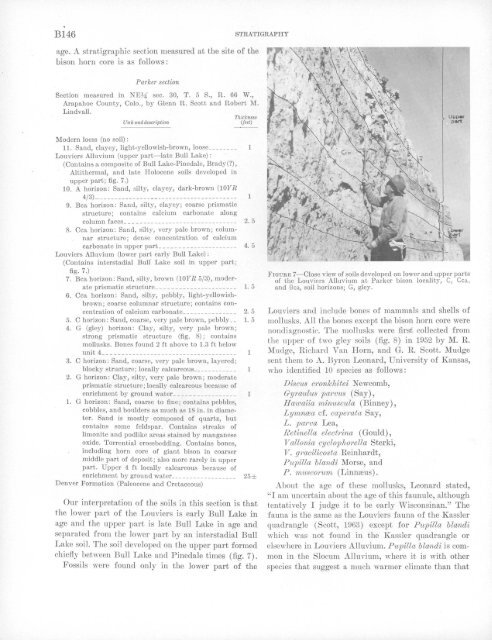RESEARCH· ·1970·
RESEARCH· ·1970·
RESEARCH· ·1970·
Create successful ePaper yourself
Turn your PDF publications into a flip-book with our unique Google optimized e-Paper software.
B146<br />
STRATIGRAPHY<br />
age. A stratigraphic section measured at the site of the<br />
bison horn core is as follows :<br />
Parker section<br />
Section measured in NE;!4 sec. 30, T. 5 S., R. 66 W.,<br />
Arapahoe County, Colo., by Glenn R. Scott and Robert M.<br />
Lindvall.<br />
Thickness<br />
Unit and description<br />
(feet)<br />
Modern loess (no soil) :<br />
11. Sand, clayey, light-yellowish-brown, loose________ 1<br />
Louviers Alluvium (upper part-late Bull Lake):<br />
(Contains a composite of Bull Lake-Pinedale, Brady(?),<br />
Altithermal, and late Holocene soils developed in<br />
upper part; fig. 7.)<br />
10. A horizon: Sand, silty, clayey, dark-brown (10YR<br />
4/3)--------------------------------------- 1<br />
9. Bca horizon: Sand, silty, clayey; coarse prismatic<br />
structure; contains calcium carbonate along<br />
column faces ______ __________ _________ ______ 2. 5<br />
8. Cca horizon: Sand, silty, very pale brown; columnar<br />
structure; dense concentration of calcium<br />
carbonate in upper part_________ ____ ________ 4. 5<br />
Louviers Alluvium (lower part early Bull Lake):<br />
(Contains interstadial Bull Lake soil in upper part;<br />
fig. 7 .)<br />
7. Bca horizon: Sand, silty, brown (1 0YR 5/3), moderate<br />
prismatic structure ___________________ -__ 1. 5<br />
6. Cca horizon: Sand, silty, pebbly, light-yellowishbrown;<br />
coarse columnar structure; contains concentration<br />
of calcium carbonate__ _____________ 2. 5<br />
5. C horizon : Sand, coarse, very pale brown, pebbly__ 1. 5<br />
4. G (gley) horizon: Clay, silty, very pale brown;<br />
strong prismatic structure (fig. 8); contains<br />
mollusks. Bones found 2 ft above to 1.3 ft below<br />
unit 4 ________________________ ------------- 1<br />
3. C horizon: Sand, coarse, very pale brown, layered;<br />
blocky structure; locally calcareous__ _________ _ 1<br />
2. G horizon : Clay, silty, very pale brown; moderate<br />
prismatic structure; locally calcareous because of<br />
enrichment by ground water_______ __________ 1<br />
1. G horizon: Sand, coarse to fine; contains pebbles,<br />
cobbles, and boulders as much as 18 in. in diameter.<br />
Sand is mostly composed of quartz, but<br />
contains some feldspar. Contains streaks of<br />
limonite and podlike areas stained by manganese<br />
oxide. Torrential crossbedding. Contains bones,<br />
including horn core of giant bison in coarser<br />
middle part of deposit; also more rarely in upper<br />
part. Upper 4 ft locally calcareous because of<br />
enrichment by ground water__________________ 25±<br />
D enver Formation (P aleocene and Cretaceous)<br />
Our interpretation of the soils in this section is that<br />
the lower part of the Louviers is early Bull Lake in<br />
age and the upper part is late Bull Lake in age and<br />
separated from the lower part by an interstadial Bull<br />
Lake soil. The soil developed on the upper part formed<br />
chiefly between Bull Lake and Pinedale times (fig. 7).<br />
Fossils were found only in the lower part of the<br />
FIGURE 7-Close view of soils developed on lower and upper parts<br />
of the Louviers Alluvium at Parker bison locality, C, Cca,<br />
and Bca, soil horizons; G, gley.<br />
Louviers and include bones of mammals and shells of<br />
mollusks. All the bones except the bison horn core were<br />
nondiagnostic. The mollusks were first collected from<br />
the upper of t.vo gley soils (fig. 8) in 1952 by M. R.<br />
Mudge, Richard Van Horn, and G. R. Scott. Mudge<br />
sent them to A. Byron Leonard, University of Kansas,<br />
who identified 10 species as follows:<br />
Dismts cronlchitei Newcomb,<br />
Gymuhts parvus (Say),<br />
H awaiia minuscula (Binney) ,<br />
Lymncea cf. caperata Say,<br />
L. parva Lea,<br />
Retinella electrina (Gould),<br />
Vallonia cyclophorella Sterki,<br />
V . gmcilicosta Reinhardt,<br />
P~tpilla blandi Morse, and<br />
P. m~tscontm (Linnreus).<br />
About the age of these mollusks, Leonard stated,<br />
"I am uncertain about the age of this faunule, although<br />
tentatively I judge it to be early ·wisconsinan." The<br />
fatma is the same as the Louviers fatma of the K assler<br />
quadrangle (Scott, 1963) except for Pupilla blandi<br />
which was not found in the Kassler quadrangle or<br />
ebewhere in Louviers Alluvium. P~tpilla blandi is common<br />
in the Slocum Alluvium, where it is with other<br />
species that suggest a much warmer climate than that
















